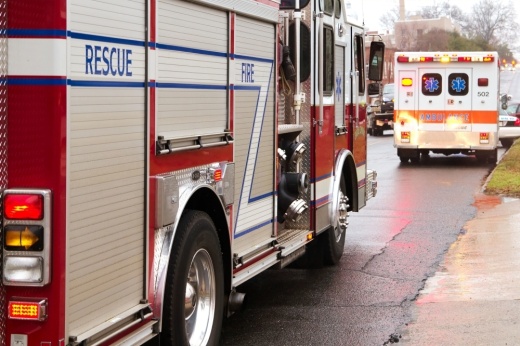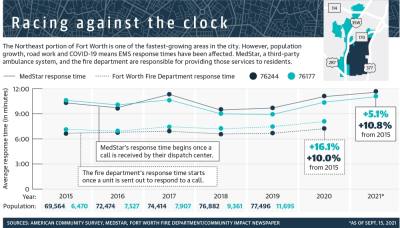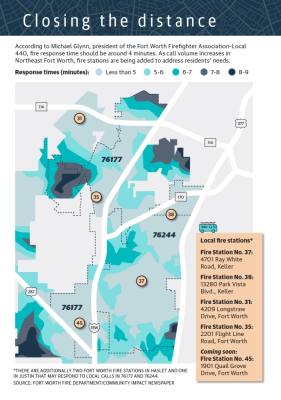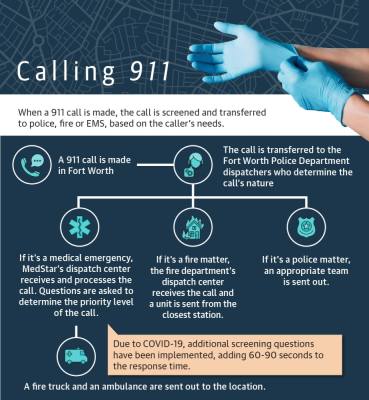The city of Fort Worth has seen around a 12% increase in call frequency and is working to address citizens’ needs. This includes constructing a 45th fire station in the Alliance area, recruiting new staff and completing road projects in Northeast Fort Worth to allow for better access.
Fort Worth has 44 fire stations—one of which is seasonal, meaning it is not in constant operations—and another one on the way on the north side of town. MedStar, a mobile health care system tasked with providing ambulance services to the city of Fort Worth, has two deployment centers in the city of Fort Worth, one of which is in the Alliance area.
The rapid population growth in ZIP codes 76177 and 76244—which increased by 203.9% and 40.6%, respectively, between 2011 and 2019, according to the U.S. Census Bureau’s American Community Survey—means increased demand for EMS services in the country’s 12th largest city.
“We’re aware of the issue, very much so, that the response times have been going up a little bit. [A representative at the fire department] shared that there’s actually been an increase in the [call volumes]...,” District 7 Council Member Leonard Firestone said. “Then, secondarily, what compounds the problem is any traffic and congestion that they encounter along the way.”
The northeast side of Fort Worth is considered one of the fastest-growing areas of the Dallas-Fort Worth metroplex due to the successful Alliance Town Center, busy Alliance Airport and the recent nearby relocation of major company headquarters such as Charles Schwab.
Determining root causes
The increased call volume—a direct result of a growing population—means the Fort Worth Fire Department and MedStar have to use their limited resources to meet a higher demand.
The Fort Worth Fire Department is expected to report nearly 135,000 calls for EMS and fire in 2021, compared to about 120,000 calls in 2020. According to its 2020 annual report, the department saw a 65% increase in calls outside Loop 820 since 2010, indicating growth and development in the city’s suburbs.
“We work hand in hand with MedStar,” said Michael Drivdahl, public information officer for the Fort Worth Fire Department. “MedStar does all the transportation [of patients] in the city of Fort Worth, and our fire department also provides EMS response as well.”For residents in ZIP codes 76177 and 76244, the average response time once a call is received by MedStar is 11:03 minutes and 11:33 minutes in 2021 respectively compared to over 10 minutes in downtown. In 2015, the response time for 76177 and 76244 was 10:31 and 10:25 minutes respectively.
The Fort Worth Fire Department’s response time from the moment a unit is sent out to the scene for areas outside Loop 820 increased from 5.56 minutes in 2011 to 6.61 minutes in 2020. Michael Glynn, president of the Fort Worth Firefighter Association-Local 440, said the standard response time for fire should be around 4 minutes.
“I believe part of our problem is that... the fire truck that ordinarily would respond within that four minutes is out on another call. And then now you’ve got another station that’s got to respond to that call,” Glynn said. “So they’re not four minutes away, they may be five or six minutes away, because they’re in a different territory.”
Matt Zavadsky, chief transformation officer for MedStar, said recently-added COVID-19 screening questions used to detect potential symptoms have been affecting response times.
“This additional screening adds about 60-90 seconds to the call-taking process unless the call is a very high priority, such as unconscious/not breathing, etc. as those calls are dispatched right away,” Zavadsky said in an email.
Drivdahl said the Fort Worth Fire Department also has 150 paramedics on hand to assist with emergencies, and every firefighter also has basic EMT certification.
Fort Worth’s fire department has a budget set for 953 firefighters, but Glynn said the department could use another 254 firefighters.
“We can use more units, more apparatus, more fire engines and more fire trucks,” he said.
Along with higher call volumes, both Drivdahl and Zavadsky said the nationwide shortage of paramedics in ambulance systems is another factor affecting daily operations.
Zavadsky said many EMTs leave to go work at hospitals or fire departments, which often offer better pay and better work hours. At the same time, the increased risk of contracting COVID-19 while on the job means more employees are quarantining.
“We have on any given day seven, eight of our employees who are on quarantine for exposure and/or testing positive for coronavirus,” he said. “That impacts our ambulance staffing. ... However, what confounds that is our response volume has dramatically increased... [with] almost the same, maybe a little bit less resources on the street.”
New facilities and staff
Before the completion of MedStar’s second deployment center near Medical City Alliance, the mobile health care service’s only home base was in west Fort Worth. The new center in Alliance, which became operational in March 2020, allowed MedStar to improve its efficiency and effectiveness.
Zavadsky said the construction and expansion of hospitals in the city’s northern reaches encouraged patients to stay in that area for services rather than travel downtown for medical attention.
“Twelve years ago ... [MedStar] didn’t have a lot of calls up there. Well now ... there are a lot of people living up there, and that increases the call volume. So it makes sense for us to have a deployment center in an area where there’s higher call volume as opposed to 10 years ago,” he said.
To continue improving response times, the city of Fort Worth is building a 45th fire station estimated at $4.6 million on Quail Grove Drive. Officials broke ground this summer and construction is expected to last 12 months.
“Every city that’s growing as fast as we are is facing [a similar issue]... You’ve got to balance building a new fire station with response times, and that’s always a difficult thing to do,” Drivdahl said, citing balancing costs and lag time between building the station and having it operational.
Alongside additional facilities, both entities are recruiting more staff. MedStar welcomed one of its largest new hire academy classes in August with 37 recruits. The September class recently welcomed 26 recruits, Zavadsky said.
Road initiatives
The city is also working to address congestion and roadblocks in the area that may cause delays in response times, Council Member Firestone said.
One initiative is the $43.6 million reconstruction of Avondale Haslet Road, which will reduce congestion and improve mobility. Construction is expected to begin in spring 2024 and last through winter 2026.
“We are definitely, as a city, working hard to bring relief to as much congestion as we can. And probably what you’ll see is, in the next bond package, several different initiatives to address some of the issues up there, specifically in the northwest side and northeast side of the district,” Firestone said. “[But] it’s complicated because there are many different stakeholders involved. So it’s just not an issue that the city can resolve by itself.”
Fort Worth is looking to present a transportation bond to residents in 2022 to address mobility issues throughout the city. Tarrant County is holding a bond election in November that will also help fund transportation projects in Northeast Fort Worth.









